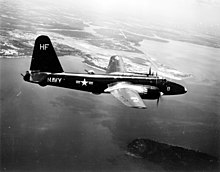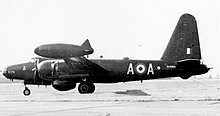Lockheed P-2 Neptune
The Lockheed P-2 Neptune (designated P2V by the United States Navy prior to September 1962) is a maritime patrol and anti-submarine warfare (ASW) aircraft.Development of a new land-based patrol bomber began early in World War II, with design work starting at Lockheed's Vega subsidiary as a private venture on 6 December 1941.On 19 February 1943, the U.S. Navy signed a letter of intent for two prototype XP2Vs, which was confirmed by a formal contract on 4 April 1944 with a further 15 aircraft being ordered 10 days later.The Convair B-36, several Boeing C-97 Stratofreighter, Fairchild C-123 Provider, North American AJ Savage, and Avro Shackleton aircraft were also so equipped.In normal US Navy operations, the jet engines were run at full power (97%) to assure takeoff, then shut down upon reaching a safe altitude.The jets were also started and kept running at flight idle during low-altitude (500-foot (150 m) during the day and 1,000-foot (300 m) at night) anti-submarine and/or anti-shipping operations as a safety measure should one of the radials develop problems.Before the P-3 Orion arrived in the mid-1960s, the Neptune was the primary U.S. land-based anti-submarine patrol aircraft, intended to be operated as the hunter of a '"Hunter-Killer" group, with destroyers employed as killers.Several features aided the P-2 in its hunter role: As the P-2 was replaced in the US Navy by the P-3A Orion in active Fleet squadrons in the early and mid-1960s, the P-2 continued to remain operational in the Naval Air Reserve through the mid-1970s, primarily in its SP-2H version.At the end of World War II, the US Navy felt the need to acquire a nuclear strike capability to maintain its political influence.It was replaced in this emergency role by the North American AJ Savage (transferred to the Pacific Fleet in October 1952) the first nuclear strike aircraft that was fully capable of carrier launch and recovery operations; it was also short-lived in that role as the US Navy was adopting fully jet powered nuclear strike aircraft.Next year, an air defense radar mapping mission was also flown by 34th Squadron's RB-69A/P2V-7U aircraft into North Vietnam and Laos on the night of 16 March 1964.During these sorties the Neptunes warned American aircraft operating over North Vietnam of Vietnamese surface to air missile launches.Armament included two torpedoes, mines, depth charges, bombs carried internally plus unguided rockets mounted under the wings.[29] The third production P2V-1 was chosen for a record-setting mission, ostensibly to test crew endurance and long-range navigation but also for publicity purposes: to display the capabilities of the US Navy's latest patrol bomber, and to surpass the standing record set by a Japanese Tachikawa Ki-77.[30] Loaded with fuel in extra tanks fitted in practically every spare space in the aircraft, "The Turtle" set out from Perth, Australia to the United States.With a crew of four (and a nine-month-old gray kangaroo, a gift from Australia for the National Zoo in Washington, D.C.) the aircraft set off on 9 September 1946, with a RATO (rocket-assisted takeoff).


























Maritime patrolanti-submarine warfareManufacturerLockheedUnited States NavyJapan Maritime Self-Defense ForceRoyal Australian Air ForceRoyal Canadian Air ForceKawasaki P-2JLockheed PV-1 Ventura and PV-2 HarpoonLockheed P-3 OrionNAS Jacksonvilleletter of intentConvair B-36Boeing C-97 StratofreighterFairchild C-123 ProviderNorth American AJ SavageAvro ShackletonWestinghouse J34National Naval Aviation MuseumP-3 OriondestroyersSonobuoysMagnetic Anomaly DetectorAN/APS-20Naval Air ReserveUSS Franklin D. RooseveltFat ManPacific FleetCentral Intelligence AgencySkunk WorksBurbank, CaliforniaELINT/ferretEdwards AFBEglin AFBWiesbadenWest GermanyHsinchu Air Baseblack opBlack Bat SquadronRepublic of China Air Forcemainland Chinaplausible deniabilityRepublic of ChinaNAS AlamedaDavis-Monthan AFBVietnam WarCam Ranh Air Basemorse codeObservation Squadron 67 (VO-67)Presidential Unit CitationIgloo WhiteHo Chi Minh trail34th Black Bat Squadron'sELINT/SIGINTDa Nang Air BaseThanh Hóa ProvinceNorth VietnamGulf of TonkinHaiphongearly warning radarHMAS SydneyArgentine Naval AviationOperation SoberaniaFalklands WarDassault Super ÉtendardsHMS SheffieldDirty WarArgentine Air ForceLockheed C-130 HerculesAvro LancasterCanadair CP-107 ArgusRoyal Air ForceCoastal Commandairborne early warningGrumman S-2 TrackersDutch New GuineaPhos-ChekKawasakiaerial firefightingBritish Aerospace 146Tachikawa Ki-77kangarooNational Zoo in Washington, D.C.Columbus, OhioBoeing B-52 StratofortressRutan VoyagerNational Museum of Naval AviationNAS PensacolaVAH-21Fox FieldU.S. Army Aviation MuseumFt. NovoselWright R-3350-8Tiny TimOperation Deep Freezeturbo-compound enginesOperation Igloo WhiteAUM-N-2 Petrelanti-ship missilesRoyal Netherlands NavyminigunsnapalmFulton Skyhook systemCalifornia wildfires of October 2007Argentine NavyNo. 10 Squadron RAAFNo. 11 Squadron RAAFBrazilian Air ForceCanadaNo. 404 Squadron RCAFNo. 405 Squadron RCAFNo. 407 Squadron RCAFFrench Naval AviationBAN Nîmes-GaronsBAN TontoutaAir Patrol Squadron 3 (JMSDF)Air Patrol Squadron 2 (JMSDF)Air Development Squadron 51 (JMSDF)Dutch Naval Aviation ServicePortuguese Air ForceMontijo Air BasePortuguese GuineaCape VerdeLuanda Air BaseAngola